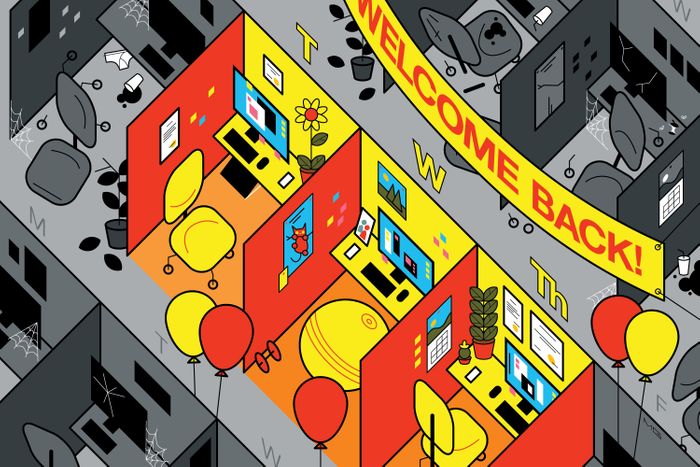
Last month, after the departure of several high-profile executives, Apple walked back its three-day-a-week return-to-the-office policy, which had been slated to go into effect in late May. The company cited the rising number of COVID-19 cases, but the real reason, it seems, was simply that employees didn’t want to. (They’re still required to come in twice a week, making COVID a pretty weak excuse for the policy shift.) Apple is only the latest and highest-profile company to discover that the three-day office week — that eminently reasonable-sounding middle ground for which proposals were widely circulated last year, and subsequently was championed by Mayor Eric Adams, office landlords, and CEOs everywhere — is, in practice, kind of a flop.
“A lot of companies that had been in the news standing firm on their return policies did back up,” said Elise Freedman, a workforce-transformation-practice leader at Korn Ferry who is helping companies coordinate their return-to-office plans. “It’s a very interesting situation. There are no one-size-fits-all answers, no silver bullet. No matter what you do, it’s not going to work for all employees.” Even financial firms, perhaps the most gung ho about return-to-office policies, have mostly caved, resigning themselves to a hybrid future that has, in many cases, stalled out at two-day-a-week callbacks. Only Goldman Sachs seems to be holding firm.
What makes the three-day week so unpersuasive? For some employees, it’s fear of COVID, but as many people have pointed out, the virus is hardly dissuading most of them from doing other things. “People are at dinner, the movies, they’re around. People are learning to live with COVID,” said Freedman. “What they liked was the flexibility.” And while virus variants and surges have been a useful excuse for companies that want to save face after workforce revolts, it is by now clear that the COVID waves will likely keep hitting, so we are, at some point, headed for a return-to-work reckoning. Companies will either need to call everyone back in spite of the virus or give up on a mandatory return.
At the moment, though, we’re in a holding pattern, largely resigned to some kind of hybrid model, the specifics of which are muddy, with return dates continually being postponed. The New York Times, scheduled for a hybrid return in early June, has since put off its plans in the face of rising case numbers. “We’ve paused the start of our expected phase of return to office until conditions improve. We’re closely watching public health trend lines and guidance and look forward to beginning a broader, gradual return as conditions allow,” a spokesperson for the company wrote.
In New York, only 8 percent of workers are in the office five days a week, according to the latest survey from the Partnership for New York City. Seventy-eight percent of workplaces have adopted a hybrid model, compared to 6 percent before the pandemic. “It’s a complete turnabout. It’s quite revolutionary,” Kathryn Wylde, the Partnership’s president, told the New York Times. “The employers have come kicking and screaming to this position. They’re not thrilled.” At the moment, 38 percent of New York office workers are at their desks on any given weekday, a number that’s expected to creep up to 49 percent after Labor Day, according to the Partnership. But we’ve all heard overoptimistic return predictions before.
There are exceptions. Tesla just mandated that everyone return to the office a minimum of 40 hours a week — and not “some remote pseudo” office, as a later memo to employees clarified. Google recently established a three-day week, after its first three attempts to call workers back didn’t take. But unlike Apple, Google will allow some employees, with their managers’ blessing, to work remotely indefinitely — a loophole that theoretically, at least, serves as a release valve for dissent. (They can also work from anywhere but will have to take pay cuts if they relocate from “premium plus” cities like New York and San Francisco to cheaper areas of the country.) The company’s chief people officer would also like to implement a flexible model where employees decide which days to come in each week depending on what they need to get done, according to Fortune, which sounds sensible, but is much harder to manage — and enforce — than a set pattern. And so far, no one knows if this experiment will actually stick, as Fortune points out: “Of all the possible configurations of this new world order, hybrid is by far the hardest to implement. We know how to work from an office, and the last two years have taught many of us how to do our jobs from home. But we have not yet proved that we can maintain a balance that falls somewhere in between.”
That’s because it raises so many messy questions. Do companies mandate that different teams show up on different days? Leave it all up to the staff? The latter seems like a good way to lure reluctant workers back, but it also means that their office experience will vary and perhaps feel pointless. “If you let people totally choose when to come in themselves, they tend to pick Tuesday, Wednesday, and Thursday, so the offices are full on those days and empty on Monday and Friday,” said Freedman. “The people who do come in then are like, ‘Why am I here? I’m on Zooms all day.’ If you want people to return, the reason why they’re coming in has to be clear — it has to be, ‘We’re in because we’re collaborating.’ Not ‘Because we want to make sure you’re working.’” At the same time, it can feel pointless to be forced to commute to a desk when you know you have a day of Zooms anyway.
As many people who’ve returned have also discovered, after years of working from a corner of the bedroom, it can also be hard to get any work done at work. Jay Carter, who works in marketing for a designer lighting company that has a three-day-a-week office policy, said that after every COVID-related closure, “having to reacclimate is awkward. After work-from-home lulls, me and my colleague, we’re both talkative people, and we’ll want to shoot the shit all day. Now that we’re in more consistently, we’ll just talk for five or ten minutes.” Carter said that he likes going in three days a week — the variety is nice — but added that it can be hard because the rest of the city isn’t back on a regular office schedule yet and everything in Manhattan seems to close early. He had to switch gyms because his old one no longer stays open late.
Most of all, after two-plus years, working from home is no longer novel and people have found new routines that they don’t want to change. Last year, Jeffrey Beers International, a design studio in the Financial District, mandated that all employees return five days a week. This May, the company rolled it back to three days, Tuesday through Thursday, to avoid losing staff to more flexible companies. John Henderson, a managing director, believes that because the company eased up rather than cracking down, the changes have been positively received. “It’s been a pretty easy transition for us, I think because we did take a hard stance early on,” he said. “When we rolled it back in May, it was like, ‘Yippee, we get to work two days a week from home.’” Many of the bigger tech companies, he added, had been “way too lenient” with return-to-work policies, pushing back dates until they lost credibility with employees, who now refuse to return — a situation that he thinks will ultimately hurt the entry-level workforce.
The thing is, if companies could get workers to start going back to the office part-time again, if it had not turned into the battle of wills that it is, workers may find that, at least to some extent, they like it. Howard Abrams, a mortgage underwriter, started with a mandated two-day-a-week return in July 2020, which the company has since bumped up to three. His company, he says, was considerate enough to ask people whether they liked the days they had. He’s home in Park Slope on Mondays and Tuesdays, when he can deal with alternate-side parking, which means he can use his car on Sundays without stressing about parking, and enjoys seeing colleagues Wednesday through Friday, mixing up his midday walk and working from a spacious office rather than an apartment. But, he adds, “I would never want to go back to five days. I would not be happy.”
What workers appear to want, more than luxurious amenities, free lunch, or even Lizzo concerts, is to know why they’re going back after years of demonstrating that they can do their jobs just fine from home. They want justification for the sad desk salads, all the hours lost to commuting, wearing professional clothes. (Those first few days of hard shoes can be a real wake-up call.) It’s unclear to many of them whether those things are outweighed by the fun parts of office life: the energy, the community, the banter and gossip. Or whether there will even be fun parts of office life again, with hybrid scheduling and COVID. For workers to accept a three-day workweek, the office needs to feel something like it did before they left. That is, not just a physical space, the design specifics of which are, in the end, beside the point, but someplace essential.
